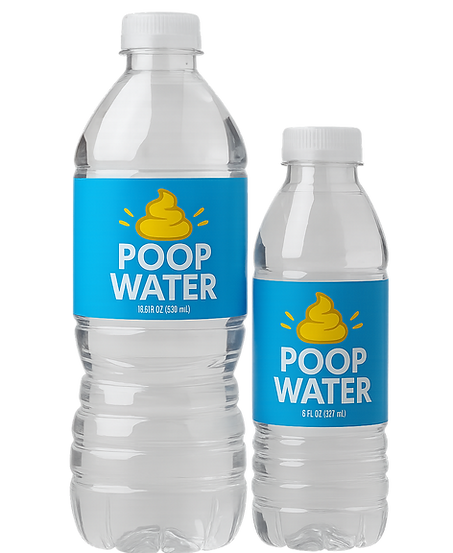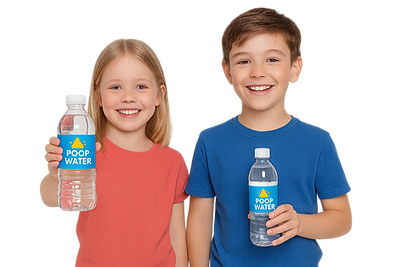



Our Mission: Why Poop Water? Because It’s Always Been This Way
At Poop Water, we mix nature, science, and humor to change how people think about water.
Let’s face it: all water is recycled. Every sip you take has been on a wild ride—from prehistoric swamps and dino guts to modern-day purification systems. We just decided to be honest about it.
Our water goes through advanced, multi-stage filtration—turning wastewater into some of the cleanest, best-tasting water on Earth. The same tech that keeps cities hydrated now fits in your bottle.
Poop Water isn’t just a drink—it’s a movement. We’re breaking taboos, sparking conversations, and giving back. 7.5% of profits go to Water.org to support global clean water access, with plans to give even more.
Because let’s be real: all water might’ve been poop water. We’re just the first to label it with pride. Clean, sustainable, and boldly honest—Poop Water is how the future drinks.
FAQ
Is Poop Water safe for kids?
Oh yeah—Poop Water is 100% safe for kids. It’s just clean, purified water with a ridiculous name that makes kids laugh and parents question their life choices (in a good way). No sugar, no caffeine, no weird stuff—just hydration with a sense of humor.
And here’s the cool part: Poop Water actually gets kids talking about clean water. We know, that sounds like a guaranteed nap—but slap “Poop” on the label and suddenly you’ve got a conversation they’ll never forget. Why is it called that? Where does clean water come from? Why doesn’t everyone have it? Boom—teachable moment.
So yes, it’s totally safe, genuinely good for them, and sneaks a little awareness into their day… wrapped in a fart joke. You're welcome.
.


FAQ
Is Poop Water good for everyone?
Absolutely. Poop Water is scientifically* proven to be good for all humans, regardless of age, race, religion, or favorite pizza topping. Your body is already made up of roughly 70% Poop Water (give or take a few giggles), and it’s constantly begging for a refill. Unlike soda, which just makes you burp and regret life, Poop Water actually hydrates you and makes you slightly more majestic. Whether you're running a marathon or binge-watching reality TV, Poop Water is the perfect companion. It doesn’t discriminate—it hydrates. Some say it nourishes the soul, but we’re still waiting for the lab results on that. It’s basically the Beyoncé of beverages: universally loved and probably a little too powerful. Other water brands may try, but they simply don’t have the guts—or the name. So drink up, friend. Your body (and your sense of humor) will thank you.e.
.
🌍 1. 1 in 4 people lack safe drinking water
According to the WHO and UNICEF, over 2 billion people do not have access to safely managed drinking water services.
🚱 2. Nearly half the world lacks safe sanitation
3.6 billion people live without safely managed sanitation — a major contributor to waterborne diseases.
🕳️ 3. Women and girls often bear the burden
In many low-income countries, women and girls spend hours each day walking to fetch water, limiting their access to education and economic opportunities.
🦠 4. Dirty water kills
Contaminated water causes around 485,000 deaths every year from diarrheal diseases — mostly among children under five.
🚿 5. Urban vs. rural divide
Urban areas are far more likely to have piped water. In some rural regions, less than 30% of people have basic drinking water services.
💧 6. Climate change makes it worse
Droughts, floods, and shifting rainfall patterns are increasing water scarcity and contaminating sources that once were safe.
🧼 7. Hygiene and water go hand-in-hand
Only 3 out of 5 people worldwide have access to basic handwashing facilities — crucial for disease prevention.
🏫 8. Schools without water
Around 1 in 3 schools globally lack access to basic drinking water — impacting health, attendance, and education quality.
🪣 9. 200 million hours a day
Women and girls spend over 200 million hours every single day collecting water. That’s time not spent learning or earning.
💸 10. Clean water is affordable to fix
Organizations like Water.org report that it often costs just a few dollars per person per year to provide access to clean water through sustainable local solutions.




